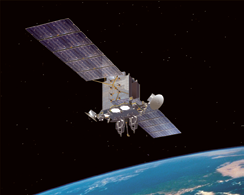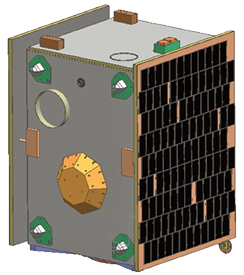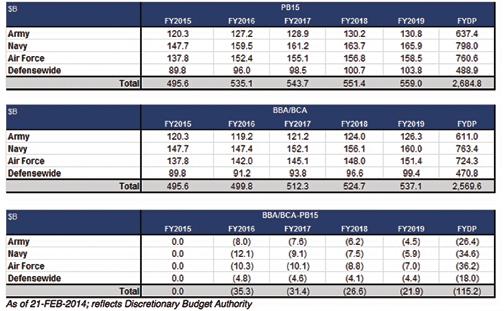DoD—SARs Summarization For Major Defense Acquisition Programs
The Department of Defense has publicly released details on major defense acquisition program cost, schedule, and performance changes since the December 2012 reporting period.
This information is based on the Selected Acquisition Reports (SARs) submitted to the Congress for the December 2013 reporting period.
SARs summarize the latest estimates of cost, schedule, and performance status. These reports are prepared annually in conjunction with submission of the President’s Budget.
Subsequent quarterly exception reports are required only for those programs experiencing unit cost increases of at least 15 percent or schedule delays of at least six months. Quarterly SARs are also submitted for initial reports, final reports, and for programs that are re-baselined at major milestone decisions.
Nunn-McCurdy Unit Cost Breaches for 2013
The December 2013 reporting period, has four programs with critical or significant Nunn-McCurdy unit cost breaches to their current or original Acquisition Program Baseline.
In accordance with the provisions of sections 2433 and 2433a of title 10, United States Code, the Department will notify Congress and provide the required unit cost breach information in the SARs for these four programs.
In addition, for the two of these programs with critical breaches, a certification determination by the Undersecretary of Defense for Acquisition, Technology and Logistics will be made no later than June 17, 2014, as required by law.
Critical Breaches:
(Unit cost increases of 25 percent or more to the current APB or of 50 percent or more to the original APB)
Joint Tactical Radio System Handheld, Manpack, and Small Form Fit Radios (JTRS HMS)—The PAUC increased 20.0 percent and the APUC increased 19.2 percent above the current APB, due to a revision in the acquisition strategy for full rate production (including a change from a single vendor per radio to multiple vendors per radio), vehicle integration requirements not previously identified as a funding responsibility of the program, and a change in the Army fielding strategy that fields fewer radios per year.
U.S. Army
Warfighter Information Network-Tactical (WIN-T) Increment 2—Program costs increased $8,969.9 million (+174.6 percent) from $5,137.4 million to $14,107.3 million, due primarily to a quantity increase of 3,167 nodes from 2,100 to 5,267 (+$6,206.3 million), which reflected the procurement of additional training base assets and a transfer of Army assets from WIN-T Increment 3 to WIN-T Increment 2.
There were additional increases in support for fielding, new equipment training, software maintenance, and initial spares resulting from the quantity increase of 3,167 nodes (+$3,015.9.0 million). These increases were partially
offset by the elimination of radio antenna requirements (-$316.6 million).
Warfighter Information Network-Tactical (WIN-T) Increment 3—Program costs decreased $14,174.6 million (-79.2 percent) from $17,890.1 million to $3,715.5 million, due primarily to a quantity decrease of 2,814 nodes from 3,513 to 699 (-$10,015.3 million) and associated schedule, engineering, and estimating allocations* (+$2,003.6 million). There were also decreases related to fewer quantities of high cost configuration items being procured (-$905.9 million) and reductions in fielding, new equipment training, hardware end of life (technology refresh), and initial spares resulting from the quantity decrease of 2,814 nodes (-$5,692.6 million).
U.S. Air Force
Evolved Expendable Launch Vehicle (EELV)—Program costs decreased $3,062.7 million (-4.3 percent) from $70,685.1 million to $67,622.4 million, due primarily to savings realized in the negotiation and award of the new 2013-2017 Phase 1 contract (-$3,770.7 million), revised cost assumptions based on the negotiated contract (-$1,511.5 million), and net decreases from a change in launch vehicle configuration requirements (-$411.3 million.
These decreases were partially offset by a quantity increase of 11 launch services from 151 to 162 (+$2,505.0 million).
MQ-9 Reaper Unmanned Aircraft System (MQ-9 Reaper)—Program costs decreased $1,451.8 million (-10.9 percent) from $13,318.2 million to $11,866.4 million, due primarily to a quantity decrease of 58 aircraft from 401 to 343 (-$962.1million), associated schedule, engineering, and estimating allocations*(+$66.9 million), and a reduction of initial spares and support equipment related to the decrease in quantity (-$432.9 million).
There were additional decreases for the removal of the Airborne Signals Intelligence payload 2C (ASIP 2C) requirement (-$280.1 million) and sequestration reductions (-$142.5 million). These decreases were partially offset by increases for a warfighter requirement for extended range retrofits and communications requirements (+$138.9 million) and the addition of production line shut down costs that were not previously estimated (+$132.7 million).
Space Based Infrared System High (SBIRS High)—Subprogram costs for the Block Buy (GEO 5-6) decreased $460.9 million (-11.9 percent) from $3,869.3 million to $3,408.4 million, due primarily to a reduced estimate to reflect a fixed price contract proposal for GEO 5-6 (-$362.4 million) and Congressional and sequestration reductions (-$118.5 million).
The entire DoD report may be accessed at http://www.defense.gov/Releases/Release.aspx?ReleaseID=16644
* Note: Quantity changes are estimated based on the original SAR baseline cost-quantity relationship. Cost changes since the original baseline are separately categorized as schedule, engineering, or estimating “allocations.” The total impact of a quantity change is the identified “quantity” change plus all associated “allocations.”
* * * * * * * * *
DARPA—Phoenix Steps Up To New Terrestrial Paradigm... New Challenges
Successful initial efforts have fueled the next steps toward developing technologies that would enable assembly of more flexible, scalable and cost-effective space systems on orbit.

The process of designing, developing, building and deploying satellites is long and expensive. Satellites today cannot follow the terrestrial paradigm of “assemble, repair, upgrade, reuse,” and must be designed to operate without any upgrades or repairs for their entire lifespan—a methodology that drives size, complexity and ultimately cost.
These challenges apply especially to the increasing number of satellites sent every year into geosynchronous Earth orbit (GEO), approximately 22,000 miles above the Earth. Unlike objects in low Earth orbit (LEO), such as the Hubble Space Telescope, satellites in GEO are essentially unreachable with current technology.
DARPA created the Phoenix program to help address these daunting challenges. Phoenix seeks to change the current paradigm by enabling GEO robotics servicing and asset life extension, while developing new satellite architectures to reduce the cost of space-based systems.
Specifically, Phoenix’s goal is to develop and demonstrate technologies that make it possible to inspect and robotically service cooperative space systems in GEO and to validate new satellite assembly architectures.
Phoenix has achieved promising Phase 1 results and has awarded eight companies prime contracts for its Phase 2 efforts.

“Phase 1 not only showed the feasibility of our robotic tools and assembly techniques, but also validated the concept that we could build new satellites on orbit by physically aggregating satlets in space,” said David Barnhart, DARPA program manager.
“These successes could eventually lead to the revolutionary ability to create new, truly scalable space systems on orbit at a fraction of current costs.”
Phoenix’s Phase 2 efforts plan to focus on developing technologies in three primary technical areas of research:
Advanced GEO space robotics: DARPA is developing a variety of robotics technologies to address key on-orbit mission needs, including assembly, repair, asset life extension, refueling, etc., in the harsh environment of geosynchronous orbit. Development activities include the maturation of robotic arms and multiple generic and mission-specific tools. These technologies would be part of a future robotic assembly platform, the Servicer/Tender.
Satlets: A new low-cost, modular satellite architecture that can scale almost infinitely. Satlets are small independent modules (roughly 15 pounds/7 kg) that incorporate essential satellite functionality (power supplies, movement controls, sensors, etc.). Satlets share data, power and thermal management capabilities.
Satlets also physically aggregate (attach together) in different combinations that would provide capabilities to accomplish a range of diverse space missions with any type, size or shape payload. Because they are modular, they can be produced on an assembly line at low cost and integrated very quickly with different payloads. DARPA is presently focused on validating the technical concept of satlets in LEO.

Payload Orbital Delivery (POD) system: The POD would be a standardized mechanism designed to safely carry a wide variety of separable mass elements to orbit—including payloads, satlets and electronics—aboard commercial communications satellites. This approach would take advantage of the tempo and “hosted payload” services that commercial satellites now provide while enabling lower-cost delivery to GEO.
DARPA is also pursuing a possible risk-reduction flight to validate the POD technology, which could eventually provide “‘FedEx®’ to GEO” capabilities to make future space deliveries to high orbit much easier and faster.
“Individually or together, these technologies could help enable not just Phoenix’s original concept of re-use, but a broad class of other robotically enabled missions at GEO as well,” Barnhart said. “They could help satellites reach new or proper orbits, inspect satellites as part of routine maintenance or troubleshooting efforts, repair or replace worn-out components, or add or upgrade capabilities. These capabilities would enable space systems, for the first time, to have the flexibility, accessibility and resilience that designers of terrestrial systems take for granted.”
DARPA has awarded prime contracts for Phase 2 of Phoenix to these companies:
• Busek
• Energid Inc.
• Honeybee Robotics
• MacDonald, Dettwiler and Associates Ltd.-Canada
• MacDonald, Dettwiler and Associates Ltd.-U.S.
• NovaWurks
• Oceaneering Inc.
• Space Systems/Loral
* * * * * * * * *
U.S. Strategic Command—Space Capabilities Integration Exercise

Artistic rendition of an AEHF satellite. Image courtesy of Lockheed Martin.
U.S. Strategic Command (USSTRATCOM) hosted a Space Table Tabletop Exercise (TTX), bringing together key leaders from the Department of Defense and Allied nations, to discuss the integration of space capabilities which provide mission-essential functions in a congested, contested and competitive space environment.
Lessons learned from the Space TTX help guide the development of capabilities, improve our ability to detect threats against U.S., international and commercial space assets and enhance the resilience of our space infrastructure.
USSTRATCOM provides Space Situational Awareness (SSA) services to increase awareness within the space domain and enhance space operations safety.
USSTRATCOM publicly shares SSA information on the Space-Track website and provides tailored information and services for owners and operators through sharing agreements to maximize spaceflight safety and the long-term sustainability of space.
* * * * * * * * *
NRL + NCEP—Navy Transitions Global Ocean Forecast System For Public Use
The U.S. Naval Research Laboratory (NRL) and the National Center for Environmental Prediction (NCEP) within the National Ocean and Atmospheric Administration (NOAA) have entered into a formal agreement that results in NCEP using Navy developed global ocean forecast model technology to make environmental ocean forecasts for public use.

This Image from the Navy Global Ocean Forecast System (GOFS) portrays sea surface temperature (SST) on January 15, 2014. The warm tropical waters can be seen to flow through the Gulf of Mexico and northward along the eastern U.S. seaboard where the Gulf Stream separates at Cape Hatteras, off the coast of North Carolina, and flows to the east. This warm water ‘conveyor-belt’ alters the ice cover across the north Atlantic. Without the ocean transport of heat, global climate and weather would be dramatically changed. (Photo: U.S. Naval Research Laboratory — Oceanography Division)
“Development of an advanced global ocean prediction system has been a long-term Navy interest,” said Dr. Gregg Jacobs, head, NRL Ocean Dynamics and Prediction Branch. “This use of Navy developed systems for global ocean forecasting represents dual use technology that will benefit civilian interests and is an excellent example of the cutting edge research that is enabled through Navy sponsored investments.”
The ability to operationally predict the ocean environment and provide this critical information had been developed within the Navy through the Office of Naval Research (ONR) and NRL research and development (R&D) investments along with Oceanographer of the Navy investments resulting in the transition of systems to the Naval Oceanographic Office (NAVOCEANO).
The Naval Meteorology and Oceanography Command that oversees NAVOCEANO is responsible for providing ocean environment forecasts utilizing meteorology and oceanography, satellite and in situ monitoring systems and geospatial information and services to enable the Navy to leverage the environment and make successful strategic, tactical, and operational battle space utilization around the globe at any time.
The Navy has had requirements for predicting the ocean environment for its purposes including estimating acoustic propagation, placement of sonar arrays, determining currents for mine drift and burial, drift for search and rescue, and safety of operations on and under the ocean surface. NRL has enabled Navy operational ocean prediction of tactically relevant information.
To accomplish this task, Jacobs says three critical components are necessary to predict the open ocean environment.
“The first is access to satellite observations that measure precise sea surface height, sea surface temperature, and ice concentration with in situ observations from public sources and Navy ships; second, numerical models representing the dynamical processes capable of understanding the physics of the ocean and numerical methods for efficiently representing those physics; and lastly, the third critical component is the technology to correct the numerical models using the observations through data assimilation.” These components have been implemented at the Naval Oceanographic Office for daily global ocean prediction.
Within NCEP, the observational components from satellite and from NOAA buoys around U.S. coasts are available publicly.
For the dynamical model, NCEP has adopted the Hybrid Coordinate Ocean Model (HYCOM) numerical model system developed through the National Ocean Partnership Program (NOPP) that NAVOCEANO runs to construct seven-day forecasts each day of the year.
The third critical piece provided to NCEP through the new agreement enables application of Navy technology to the civilian sector.
NOAA’s NCEP has a mission to provide environment forecasts to the U.S. public and has provided meteorological information for many years.
The new agreement will allow NCEP to use software developed by NRL to assimilate data necessary to maintain daily forecast accuracy that enables safe, at-sea operations, hazard mitigation, resource management, and emergency response.
“This is an example of complementary missions across agencies that, through coordinated application, leads to protecting our service personnel, who ensure the high seas are safe, and protecting our resources and citizens at home.” Jacobs said.
The Naval Research Laboratory infosite is located at http://www.nrl.navy.mil/
* * * * * * * * *
NTU—Three Year Triumph
Singapore’s first locally-built satellite—X-SAT—has traveled nearly 700 million kilometers, captured 8,000 photographs and has completed 4,400 successful commands while orbiting Earth.

All these events were achieved while the satellite survived several solar storms, hazardous radiation and more than 30 near-collisions with space debris. The X-SAT satellite marked three years in space as of this Sunday.
The 105kg microsatellite, developed by Nanyang Technological University (NTU) and DSO National Laboratories, was launched into space on April 20, 2011, on a three-year mission.
Director of NTU’s Satellite Research Centre, Associate Professor Low Kay Soon, said the fully functioning X-SAT is a technological achievement, which attests to the quality of NTU’s engineering expertise.
NTU is also the first university in Singapore to have a satellite program for undergraduates.
In addition to X-SAT, NTU also has another satellite orbiting the Earth which was launched on November 21st of last year. Named the VELOX-PII, it is designed, built and tested by undergraduate students.
This year, the university is set to launch another two student-built satellites, a 4.5kg nano-satellite named VELOX-I and a pico which will “piggyback” on the former and will separate from it after launch.
NTU has also embarked on building a weather satellite named the VELOX-CI and a core team from the X-SAT program is working on Singapore’s first commercial remote sensing satellite, TeLEOS-1. Both TeLEOS-1 and VELOX-CI are slated for launch by late 2015.
* * * * * * * * *
DoD—Gambling With National Security—Estimated Impacts For Fy2015 Defense Budget
Defense Department officials have released a report that documents the cuts to military forces, modernization and readiness that will be required if defense budgets are held at sequester-levels in the years beyond fiscal year 2015.

The report says sequester level budgets would result in continued force-level cuts across the military services.
The Army would be reduced to 420,000 active duty soldiers, along with 315,000 in the National Guard and 185,000 in the Army Reserve.
The Marine Corps would drop to 175,000 active
duty personnel.
The Air Force would have to eliminate its entire fleet of KC-10 tankers and shrink its inventory of unmanned
aerial vehicles.
The Navy would be forced to mothball six destroyers and retire an aircraft carrier and its associated air wing, reducing the carrier fleet to 10, the report says.
Modernization also would be significantly slowed, according to the report. Compared to plans under the fiscal 2015 budget, the department would buy eight fewer ships in the years beyond fiscal 2016—including one fewer Virginia-class submarine and three fewer DDG-51 destroyers—and would delay delivery of the new carrier John F. Kennedy by two years.
The services would acquire 17 fewer joint strike fighters, five fewer KC-46 tankers, and six fewer P-8A aircraft, the report says, adding that many smaller weapons programs and funding for military construction also would see sharp cutbacks.

In addition, the report says, the Defense Department would invest about $66 billion less in procurement and research funding compared with levels planned in the fiscal 2015 budget.
The report notes that sequester-level budgets would worsen already-existing readiness shortfalls across the force and would delay needed training to prepare the joint force for full-spectrum operations.
Overall, the report says, sequester-level cuts would result in a military that is too small to fully meet the requirements of its strategy, thereby significantly increasing national security risks both in the short- and long-term.
“As Secretary Hagel has said, under sequester-level budgets, we would be gambling that our military will not be required to respond to multiple major contingencies at the same time,” officials said in the release announcing the report.
The full DoD report is available at http://www.defense.gov/pubs/2014_Estimated_Impacts_of_Sequestration-Level_Funding_April.pdf
Sample chart from the report is included at right: Service & Appropriation Level Impacts





